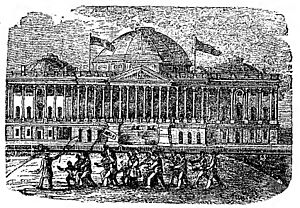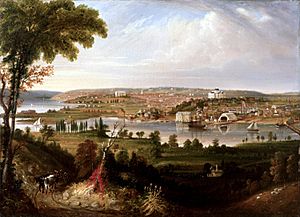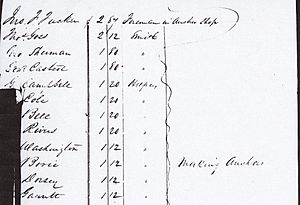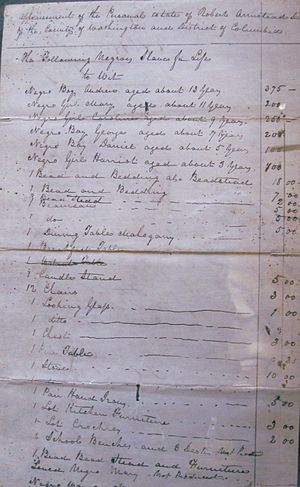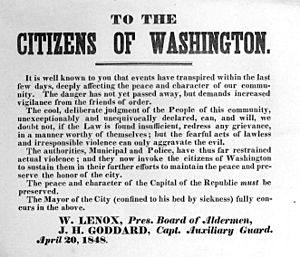Daniel Bell (freedman) facts for kids
Daniel Bell (born around 1802 – died March 1877) was an amazing man. He was born into slavery but managed to gain his own freedom. After that, he worked tirelessly to free his wife, Mary, and their children. Their journey to freedom was very long and difficult. It took many years for the Bell family to finally be free. Sadly, Daniel and Mary were even forced back into slavery after they had already become free. Even two of their children, who were born free, were later taken and enslaved.
Daniel Bell was a key organizer for a huge escape attempt. It was called "the single largest known escape attempt by enslaved Americans." He helped plan for a boat called the Pearl to take his family north from Washington, D.C., in 1848. The plan grew, and the boat ended up carrying 77 people seeking freedom. However, the boat was caught two days later. The Bell family members were taken back to Washington, D.C., and held in a slave pen to be sold. Daniel managed to buy the freedom of Mary and two of his children. But the other children were sold and sent to far-off states like Louisiana and Mississippi in the Deep South.
Some of his children were never found. Others were found after the Civil War. Some had died by 1870. One daughter and a granddaughter gained freedom through the Compensated Emancipation Act of 1862. This act freed enslaved people in Washington, D.C.. The Emancipation Proclamation was made official on December 6, 1865. This act freed any remaining enslaved relatives. Daniel and Mary Bell eventually settled down in Washington, D.C.
Contents
Daniel Bell's Early Life
Daniel Bell was born into slavery around 1802. This happened in Prince George's County, Maryland. His mother was Lucy Bell, born about 1763 in Maryland. Daniel and his sisters were first owned by Ann Greenfield. She was the wife of Gerrard Truman Greenfield. After Ann died in 1810, Daniel and his sister Harriet went to Ann's son, Gabriel Greenfield. He passed away in 1815. By 1820, Daniel may have lived with his mother and two sisters. They lived near the Navy Yard in Washington, D.C.
His mother, Lucy, became a free woman by 1850. She died on June 8, 1862. Lucy was buried in the Congressional Cemetery in Washington, D.C.
Daniel's Adult Life and Work
Daniel Bell was loaned out by his owner to work for the government. He worked in the Navy Yard's blacksmith shop. There, he cast and shaped heavy iron items. He started working there around 1828. He continued until at least 1848. People described him as "strong, worthy, and hardworking."
Daniel married Mary. She was enslaved by Robert and Susannah (Susan) Armstead. By 1835, Daniel and Mary had six children. Their ages ranged from eleven years old down to three months. Their names were Andrew, Mary Ellen, Caroline, George W., Daniel, and Harriet. Mary and her children were owned by Armistead. Mary was promised that her children would be freed when they turned 25.
The Bell Family's Fight for Freedom
On September 14, 1835, Robert Armistead signed a paper to free Mary when he died. But he said her children would not be free until they were 30 or 40 years old. Armistead died about two days later. The paper was filed in court. But his wife, Susan, did not follow the agreement. Susan Armistead said she owned the Bell children for life. Mary Bell received her freedom papers on September 21, 1835. But Susan argued that her husband was not thinking clearly when he signed the paper. So, Mary had to fight for her freedom again.
An abolitionist named Thomas Blagden bought Mary's freedom. He also bought the freedom of one child for $400 in 1847. Other abolitionists paid him back. But in December 1847, the court decided against Mary's request for freedom.
When Daniel's owner heard that Mary was freed, he arranged for a slave trader to take Daniel. Daniel was seized and put in a slave pen. He was waiting to be sold. His wife, children, and friends were very upset. Daniel's lawyers asked for his freedom on September 24, 1835. His lawyer stopped the request after a colonel agreed to buy Daniel. The colonel would receive payments for Daniel's freedom. Abolitionists helped arrange for Daniel to be bought. He would pay back the money over time. Daniel had paid almost all of the $1,000 loan when the colonel died.
Daniel did not know that the colonel had borrowed $1,000 from his sister-in-law. The colonel's family wanted the full $1,000. But the amount was lowered to about $600 by Thomas Blagden. Daniel paid a total of $1,630 to the colonel and his family. He finally received his freedom papers in 1847.
The Pearl Escape Attempt
Even though Mary and Daniel had their freedom papers, twelve of their family members were still enslaved. Daniel knew they could be taken captive again. He tried to get money in Philadelphia to buy his family's freedom, but he failed. So, Daniel began planning an escape. He worked with Samuel Edmonson and William L. Chaplin of the Underground Railroad.
They planned to use a boat called the Pearl. It would take the Bell family north from Washington, D.C., to Frenchtown, New Jersey. The boat was hidden near Seventh Avenue. The plan became even bigger. They decided to take more people, a total of 77 enslaved individuals. They started their journey on April 15, 1848. But they had to stop near Point Lookout, Maryland, because of strong winds. Slaveholders found out about the plan. They caught up with the boat in a steamer. The people seeking freedom were taken back to D.C. An angry crowd met them, which led to the Washington riot of 1848. After being held, many were sold to places like Richmond, Annapolis, and Baltimore. Others were sent to southern states.
Mary was among 50 adults and children sent by train to Baltimore to be sold. This happened on April 21, 1848. Daniel tried to stop the train. He told the slave dealer that Mary was a free woman and he had her papers. But Daniel could not get her off the train. He only managed to get enough money to buy the freedom of Mary, their son Thomas, and one other child. Most of his other children were sold and sent south, to places like Mississippi and Louisiana.
What Happened to the Bell Children
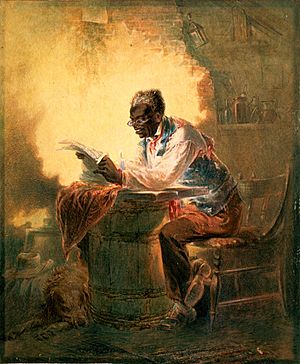
Here is what happened to eight of the Bell children:
- Andrew was not found after he was sold in 1848. This happened after the Pearl escape.
- Mary Ellen was sold to an owner in western Mississippi. She married Jordan Dawley. He served in the Union Army. He died in 1864. Mary Ellen became a widow with four children. After the war, she told her parents where she was. She remarried and lived in Mississippi.
- Caroline had a daughter named Catherine and a son named John. We do not know what happened to them. Caroline later married John Green. She lived with her mother after her father died.
- George W. was not found after he was sold in 1848.
- Daniel Jr. was sold to an owner in Louisiana. He is thought to have reunited with his parents after the war. He lived in Natchitoches, Louisiana, with his wife and eight children.
- Harriet was married to Thomas Snow. She had four children before she died between 1870 and 1875.
- Eleanor (Nora) was born free. But in 1849, she lost her case against Susan Armistead. In 1862, she was given to Sarah Jane O'Brien. Eleanor and her baby daughter Caroline were freed by the Compensated Emancipation Act of 1862. She had no more children. She is believed to have died by 1870.
- Thomas was likely born around 1845. He lived with his parents in 1850 when he was five. We do not know where he went after that time.
In 1850, Daniel, Mary, and Thomas Bell shared a house. They lived with Daniel's sister Ann Bell, his mother Lucy Bell, John Ash, Anthony Ash, and Phebe Dorsey. This was in Washington, D.C. Daniel was still in Washington, D.C., in 1870.
Later Years and Daniel's Death
Daniel Bell passed away in March 1877. He left his property to his "well beloved and devoted wife, Mary." She lived in their house in Washington, D.C. She lived with her daughter Caroline and her son-in-law. In his will from 1875, Daniel said that after Mary died, the property should go to their children Caroline, Daniel, and Mary Ellen. It would also go to their grandchildren Harriet and Elenora. Mary died in 1884.
See also
- Edmonson sisters, whose story is sometimes told with the Bell family's story
Images for kids


